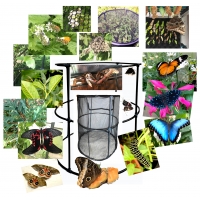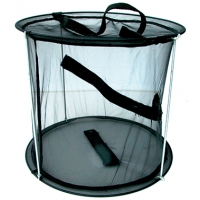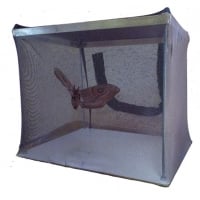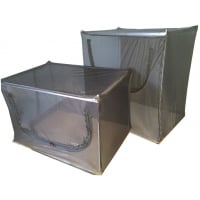CAGES

Important: Please follow guidance under Plastic Rearing Containers for keeping young larvae in a more confined space (or sleeved on growing foodplant) until they are large enough to be caged. Baby caterpillars placed in a cage will immediately wander from their food and starve.
Please see also the SLEEVE section. A very natural and successful rearing method for larvae, and less cost than cages.
Sleeves Can be used indoors, on potted plants, or cut foodplant or outside on growing plants and trees. They protect the larvae and prevent escape. A very economical and labour-saving rearing method, that often gives fresher and more natural conditions for larvae.
Pyjama Cage A new concept - excellent all-round vision - packs flat - and when the cover gets dirty or damaged, slip it off and pop it in the wash to have an almost new cage again. THREE SIZES illustrated above for size comparison MINI, STANDARD and LARGE.
This cage design suits all uses - breeding butterflies and moths, rearing larvae, emerging pupae, keeping Stick Insects and other creatures.
This type of cage is very suitable for laying out pupae to emerge. It is also more suitable for smaller numbers of larvae or younger larvae. Baby larvae should be first reared in plastic rearing containers or kept covered on growing food. According to size you can use these cages for pots of plant, net covered when you want to avoid straying, or cut foodplant in water. The larger cages have enormous capacity.
A pre-formed frame is supported by corner uprights which join the frame to the cage base. No messing with components to make the top frame. The base of the cage is finished in smooth white paint, which can easily be washed or periodically re-painted in minutes. The supports come ready fitted with fixing nuts and washers. Quickly assembled. A zip gives easy cage access. Escape is less likely than with conventional cage doors.
Practical design enabling the breeder to wash, repair or replace the netting cover in minutes. Removing eggs laid in awkward places is so easy when you can slip the cover off and replace it with a fresh one - just like changing pyjamas! Keep spare covers so you can have one on and one in the wash! For winter storage, or for travel, the cage quickly packs flat. Thorough cleaning and disinfecting is so much easier than with a fixed frame cage.
Pyjama cages show a substantial price saving too.
PUPAE NEST
The Pupae Nest, using sheets of bobble foam, is the innovative method used by WWB to keep subterranean pupae, in particular, and other pupae and cocoons in ideal conditions in the emerging cage.
• Developed specifically for underground pupae: also ideal for cocoons and unattached pupae.
• Immediate access to pupae for inspection, without disturbance.
• Provides healthy and moist conditions.
• Easy observation of pupae that are forming up prior to emergence.
• Allows the breeder to anticipate the emergence of required males or females.
• Ensures hygiene and avoidance of harmful bacteria.
This method has proved to be better than using soil or compost, because it enables instant inspection whenever required, for removal of empty pupal shells or any dead pupae, and to be able clean up, with minimum disturbance of the pupae. The pupae rest in the depressions, in natural conditions of humidity and hygiene. If they were on plain foam sheets they would roll around, and would be less able to benefit from the humidity assisted by the depressions, which also provide separation. The covering sheet of foam is placed with the bobble side down, so both of the indented sides are together, which allows some airflow and eases the passage for adults to emerge and climb to dry their wings.
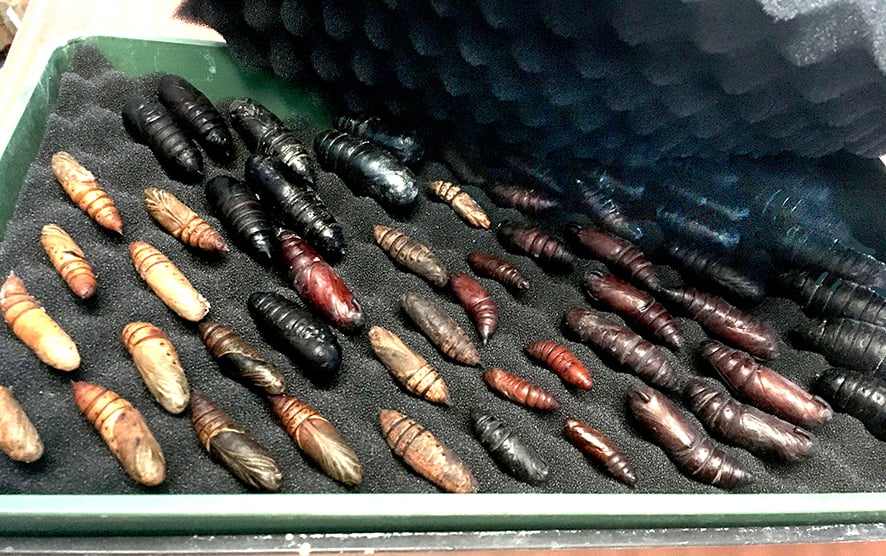
The pupae and foam should be sprayed thoroughly (not just misted) every day, or more often in higher temperatures. If already moist when you next come to spray, you can reduce or omit further spraying. The pupae and foam should be sprayed thoroughly (not just misted) every day, or more often in higher temperatures. If already very moist when you next come to spray, you can reduce or omit that day's spraying. The base of the upper tray is perforated to allow drainage. It rests in an unperforated tray with a block to separate the two trays and receive the drained water. This drainage allows liberal watering, without risk of the pupae lying in water.
Cocoons also do well resting on a bobble foam sheet, usually without another sheet covering them, though in exceptionally hot conditions, a moist foam sheet on top of the cocoons, helps to maintain humidity. Cocoons require very liberal watering, not a just a fine mist. Soak them thoroughly, safe in the knowledge that they are well drained.
Butterfly pupae, which in the wild are not formed underground, are usually fixed to a twig or other surface, either hanging from the tail cremaster, or (dependent on their family) upright and held in place by a silken girdle. You can go to the trouble of emulating this artificially (the way to suspend pupae is described in the Exotic Butterfly Pupae section) or they can be laid on the surface of the foam and not covered. As long as they are misted to avoid them drying out, the butterfly usually forms successfully in such pupae laid on foam, and the porous surface helps give the emerging butterfly the grip needed to pull itself out of the chrysalis shell, and crawl to the netting wall of the cage to expand and dry its wings.
From time to time, it is good practice to remove the pupae, wash the foam thoroughly, spray with dilute bleach (about 10% solution, which is not harmful to the pupae) then replace the pupae on nice wet foam. In summer the foam is normally washed about every 2- 3 weeks, using hot water with a touch of bleach added, but without soap or detergent which would create problems with froth and would take too long to rinse away. The washing interval depends on the extent of hatching activity and temperature. Any hint of smell, or slippery feel to the pupae, indicates bacteria, and means that washing is overdue. When adults emerge from the pupa, a waste product Meconium, is ejected. This is only harmful if left so long that it spoils the freshness and encourages bacteria. Empty pupal shells and any other organic matter, are best frequently removed, to avoid build-up of mould or bacteria. In the emerging cage, pupae that are crowded together can develop a slime, caused by bacteria, which slows development and can kill pupae. Pupae nests help to eliminate such risk and periodic washing gives maximum hygiene.
When washing the foam sheets, it is also important to wash and disinfect the two trays. If you are incubating quite a lot of pupae it makes it more convenient to have two Pupae Nests, so you can move the pupae straight into a prepared clean Nest. To encourage this, there is a price reduction for two nests bought together.
TO INCUBATE pupae and COCOONS An emerging cage should have netting sides with plenty of ventilation. This provides grip for emerging adults, and you can add some sticks. In summer conditions, you can incubate temperate pupae at room temperature, without further heating, but when it is cool you may wish to add warmth. When you heat, the ambient temperature can be raised to 25º over a few days, and increase further to 30º if required. The air around the cage needs to be heated: they don’t do so well if heat is directed at the pupae or the cage. Don't stand the cage on a heat source. You cannot over-water the cocoons as long as they are able to drain. You can hang cocoons: if you do they then need more frequent and heavy watering.
The Pupae Nest is based on standard seed tray size 24 x 38 cms which fits the Standard Pyjama Cage.

Exotic butterfly pupae should be incubated, totally shaded, in a tropical greenhouse. The ambience of a tropical greenhouse is not easy to emulate. Some breeders are successful in re-creating such conditions, but it us not sufficient simply to achieve a high temperature and humidity. For details of how to attach tropical butterfly pupae to twigs, or bamboo, please see the introduction to the Exotic Butterfly section of the WWB website. Exotic butterfly pupae that are not suspended but lying loose, can be laid on the bobble foam of a Pupae Nest, and left uncovered. Remember incubating pupae must always be in full shade.
Pyjama Cage Replacement Cover, Standard size
Replacement cover for the Standard PJ cage.
FREEDOM CAGE Multipurpose cages for larger breeding projects
The GIANT Freedom Cage has enough space to house tropical species and can be used as a portable flight cage. There is room for potted food and nectar plants and can be used outside or indoors. As well as a side access zip, the bottom can be unzipped to place the cage over a growing bush or patch of nettles or other foodplant. Release larvae, with the freedom to roam, and protected from predators.
As soon as we built the first Freedom Cage, it was immediately apparent that the same design in smaller sizes would provide a whole new facility for breeders, so the range of three evolved. The Large and Small Freedom cages will fit through a standard door way: the Giant needs more space.
All three sizes pack down into a box for storage or transport. Quick to assemble, a rigid construction is easily achieved at room temperature. Assembling in the cold means more effort to assemble the push-fit frame.
Sizes;
GIANT Height 1 metre, diameter 85cms
LARGE Height 1 metre, diameter 65 cms
SMALL Height 76 cms, diameter 50 cms
FREEDOM CAGES are ideal for pairing and egg-laying Giant Silkmoths and Hawkmoths, with or without foodplants. All three sizes are designed to open at the base, in order to place over foodplants and whole bushes. We illustrate successful breeding of Brimstone rhamni, Orange Tip cardamines and Vanessids such as Peacock Inachis io and Tortoiseshells urticae, polychloros, xanthomelas, Camberwell Beauty antiopa and more.
The more you use the FREEDOM CAGES the more you will find them useful.
For covering low-growing plants you can use the FREEDOM CAGES at half height! Just remove the bottom supports and concertina the cover to the base, and you have a superior ground cage for Blues, Fritillaries and others that use low plants.
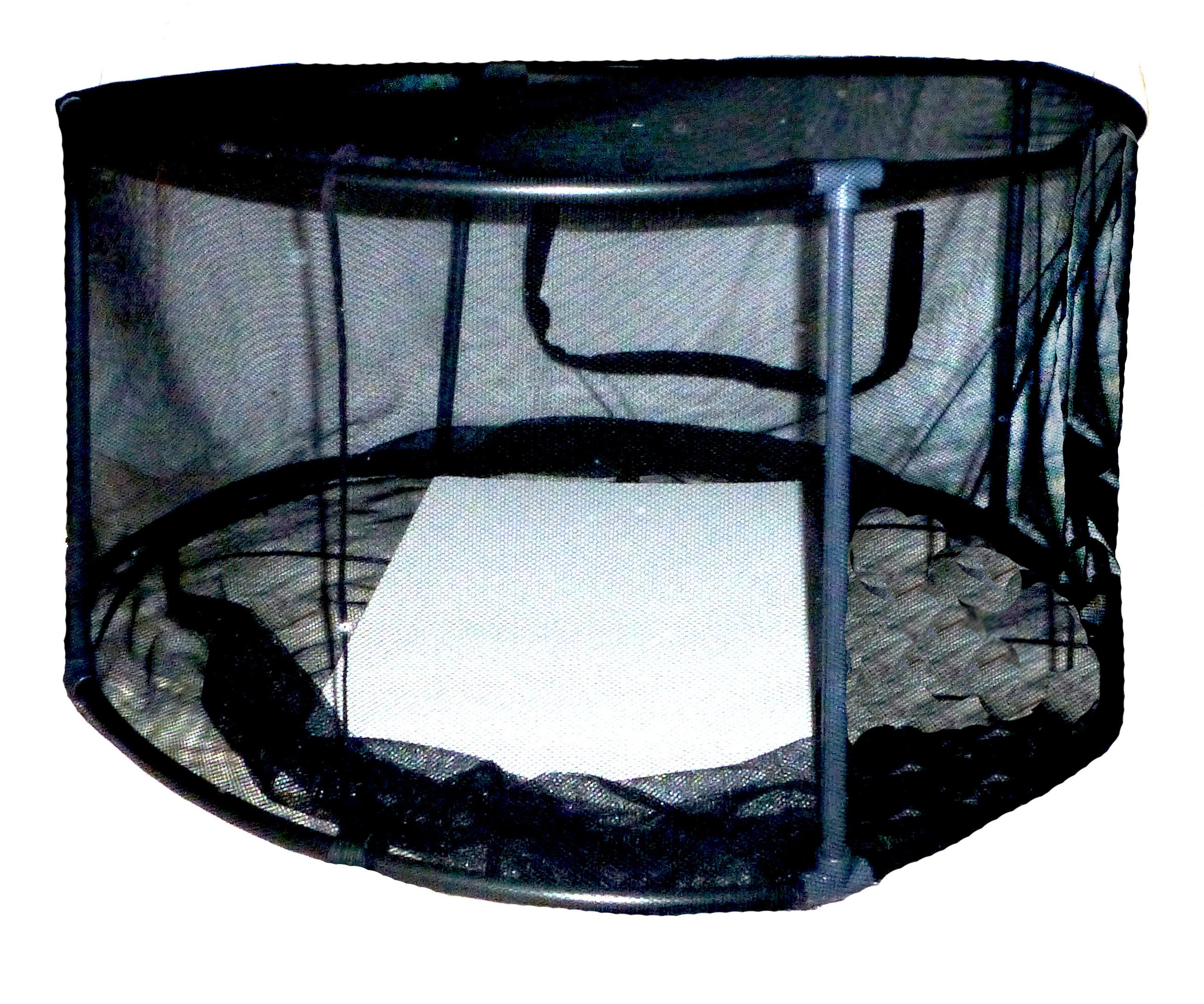
Take a look at the composite picture of the FREEDOM CAGE surrounded with pictures of some of the varied things that these new cages facilitate.
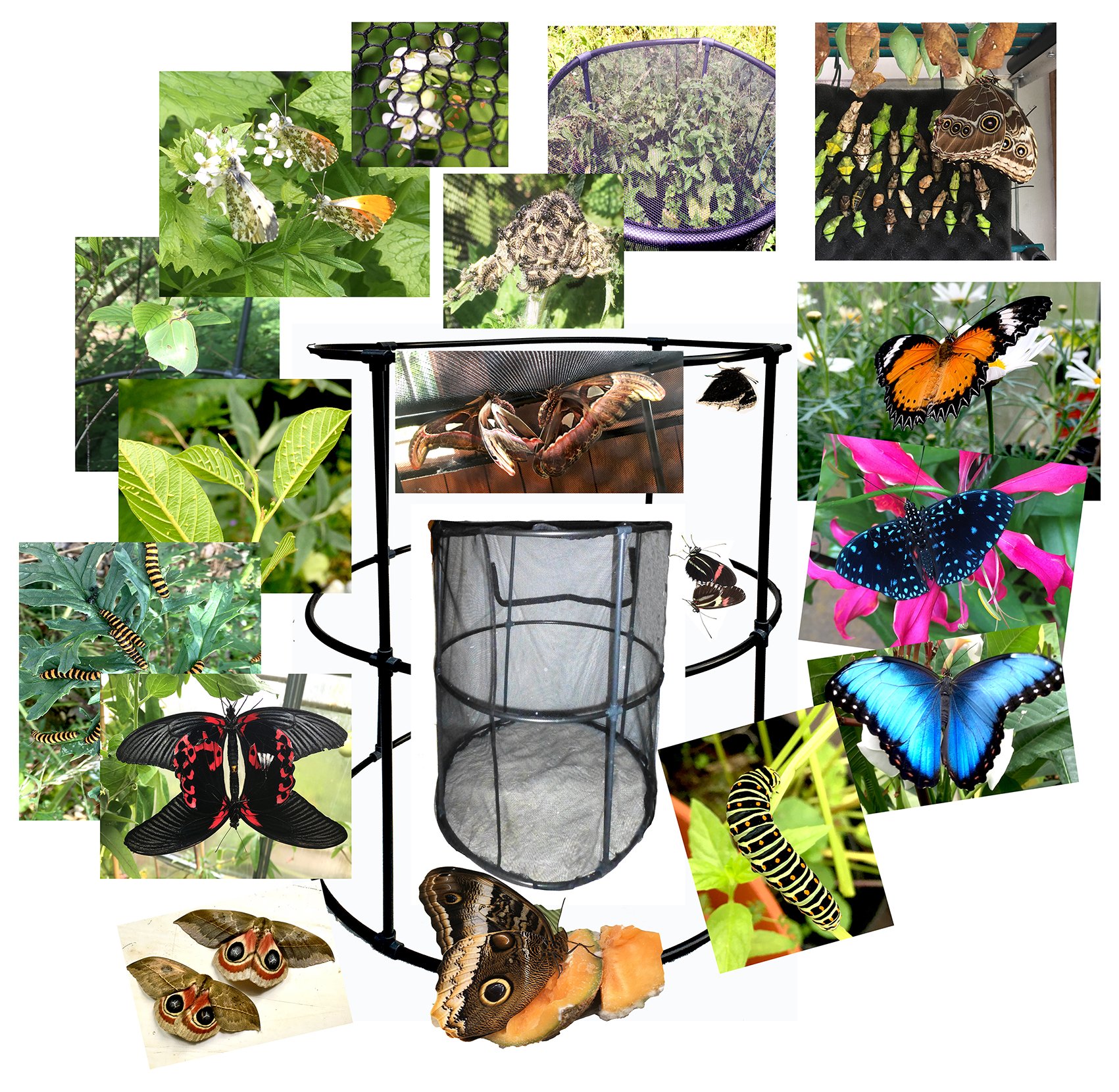
TRAVEL CAGE 30 cm diameter 20 cm high.
This cage is quite an innovation. It has been designed for convenience when travelling. But not just for travelling - this cage is very adaptable and can be used over plants indoors or outside, potted or in the ground. It folds absolutely flat. Access is by a smiley zip in the side. In the base is another zip which allows the cage to be stood on a pot of growing foodplant, or a jar of cut food and flowers. The cage has two supports so it can be stood, but it can also be hung and used as a pairing cage. The design has evolved from needs when travelling and gathering all sorts of species to breed. Half a dozen cages occupy very little space, but they give amazing facility as a cage for pupae emerging, keeping larvae, pairing, egg-laying, butterflies or moths, Stick Insects and other creatures. The Travel Cage is very versatile!
Pyjama Mini Cage 22 x 29 x 25cm high
This popular cage has just got even better. Nearly a third larger, and much improved dimensions.
Ideal as a beginner's cage, but also for the busy breeder who wants separate small cages. Excellent as an emerging cage for chrysalides and cocoons, ideal for keeping small numbers of larvae or other insects, when large enough for cage rearing.
This cage is suitable for laying out small numbers of pupae to emerge. Also for rearing smaller numbers of larvae or smaller larvae. Baby larvae should be first reared in plastic rearing containers or kept covered on growing food. Please see the note on the page for plastic rearing containers. This cage will hold small covered pots of plant, and larger sizes of cage are available for larger subjects.
When necessary the netting cover can be slipped off for cleaning or replacement. The Pyjama Mini cage is assembled in minutes and easily packed flat for winter storage. As the interest grows there are larger sizes available. For the experienced breeder the Mini Cage has many uses where a series of smaller cages is needed for separating species and giving different treatment.
The cover can be washed by hand or machine, making your used cage like new for almost no effort, and no cost.
Pyjama Cage LARGE 60 x 40 cm changeable height
This large cage is ideal for breeding larger butterflies and moths, keeping larvae of the Giant Silkmoths and Hawkmoths, or for larger numbers. It is slightly larger than the former Large (which was 50 x 38cms). It is ideal for keeping other insects such as Phasmids. With this cage you get a lot for your money!
The cage comes with both high and low supports (60 cm and 40 cm) so its height can be selected according to your choice, both initially and at any time in the future, to suit your changing requirements. The cover is designed to be used for either height. An additional base is included as a spare. At any time, if the base has become marked with use, the spare can be used to make the cage as new again. The original base can be cleaned and re-painted ready for the next time needed. The cover can be washed by hand or machine, making your used cage like new for very little effort, and no cost.
You get almost two very large cages for the price of one. This cage is less than twice the price of the Standard PJ Cage but more than twice the volume, and it has the versatility to use it as a high or low cage. STORES FLAT when not needed out of season.


